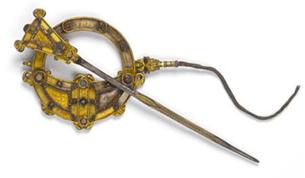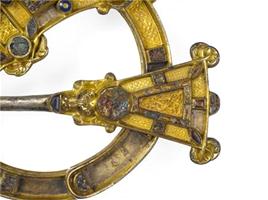| This Week’s Topic… | |||||

Best viewed in
|
The Celtic Brooch The Celtic brooch, more properly called the penannular brooch, and its closely related type, the pseudo-penannular brooch, are types of brooch clothes fasteners, often rather large. They are especially associated with the beginning of the Early Medieval period in Ireland and Britain, although they are found in other times and places. "Annular" means formed as a ring and "penannular" formed as an incomplete ring; both terms have a range of uses.
Beginning as utilitarian fasteners in the Iron Age and Roman period, they are especially associated with the highly ornate brooches produced in precious metal for the elites of Ireland and Scotland from about 700 to 900, which are popularly known as Celtic brooches or similar terms. They are the most significant objects in high-quality secular metalwork from Early Medieval Celtic art, or Insular art, as art historians prefer to call it. The type continued in simpler forms such as the thistle brooch into the 11th century, during what is often known as the Viking Age in Ireland and Scotland.
Both penannular and pseudo-penannular brooches feature a long pin attached by its head to a ring; the pin can move freely around the ring as far as the terminals, which are close together. In the true penannular type, the ring is not closed; there is a gap between the terminals wide enough for the pin to pass through. In the pseudo-penannular type, the ring is closed, but there are still two separately defined terminals, which are joined by a further element. The penannular type is a simple and efficient way of fastening loosely woven cloth (where the pin will not leave a permanent hole), but the pseudo-penannular type is notably less efficient. The brooches were worn by both men and women, usually singly at the shoulder by men and on the breast by women, and with the pin pointing up; an Irish law code says that in the event of injury from a pin to another person, the wearer is not at fault if the pin did not project too far and the brooch was worn in these ways by the sexes. The most elaborate examples were clearly significant expressions of status at the top of society, which were also worn by clergy, at least in Ireland, though probably to fasten copes and other vestments rather than as every day wear. The Senchas Mhor, an early Irish law tract, specified that the sons of major kings, when being fostered, should have "brooches of gold having crystal inserted in them", while the sons of minor kings need wear only silver brooches.
|
||||



